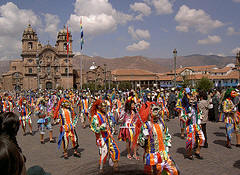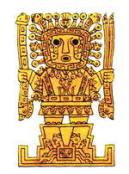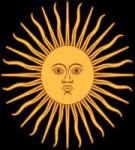Inca religious ceremonies followed the Inca calendar. The seasons of the year were very important to the Inca, because they lived off the land. Their calendar was divided into twelve lunar months, named for important agricultural and religious events. Since the seasons south of the equator are reversed, the January of the Inca calendar was the equivalent of June on North America. The calendar year began with December, which is like May in the north. Every month they had one more festivals. Inca festivals were colorful.
December or Kapac Raymi was the month of Magnificent Festival. During this month the Inca held initiation ceremonies for the sons of the nobility. January or Kamay was the month of Small Ripening. February, Hatun Poky, was the moth of the Great Ripening. March, Pakar Waray, was the month of the flowers and Earth Ripening. April, Auriwa, the month of the Dance of Young Maize, a white Llama, brushed and groomed and covered with fine cloths and gold ornaments, was paraded in the plaza before a large gathering. In May, Aymuray, festivals were held all over the Empire to celebrate the month of the Harvest.
June, Inti Raymi, was the month of festival of the Sun - the most important Inca ceremony. The people believed that the Sun was holding the celebration and that the nobility were his guests at the festival. The emperor himself over this ceremony, and every nobleman, dressed in his best and displaying all the ornaments he possessed, came to Cusco for it.

Inti Raymi is one of the most celebrated festival in Peru
July, Chawa Warkis, was the month of earth purification. During this month priests make sacrifices to the huaca which presided over the irrigation system of the Cusco valley, and similar festivals were held to honor the huacas at the irrigation canals held the huacas at the irrigation canals all over the Empire.
August, Yapakis, was the month of everyone's Purification. Sacrifices, brought to Cusco from the four provinces of the Empire, honored Water, Frost, the Air, and the Sun.
September, Koya Raymi, was a dry month, and the Queen's Festival honored the change in weather. In October, Uma Raymi, the Inca held the Festival of Water. The people prayed for the rain, because the crops that had been sown in August and September would fail without it.
In November, Ayamarka Raymi, there was the Festival of the Dead. During this festival people made offerings to their dead ancestors. It is possible that this worship of ancestors was based on a fear of the dead. The Inca may have believed that unless they treated the shades of the dead with respect, the shades might molest the living.
In additions to the these monthly ceremonies there were many others, which were held on special occasions, such as drought, an earthquake, or a war. During these ceremonies everyone who was not of noble rank had to leave Cusco. Men and boys marched in procession through the streets, wearing red shirts with long fringes and ornaments, great feathered headdresses, and shell necklaces. They carried small dried green birds and white drums. At these ceremonies the only sound was the sound of the drums; the people were silent.







